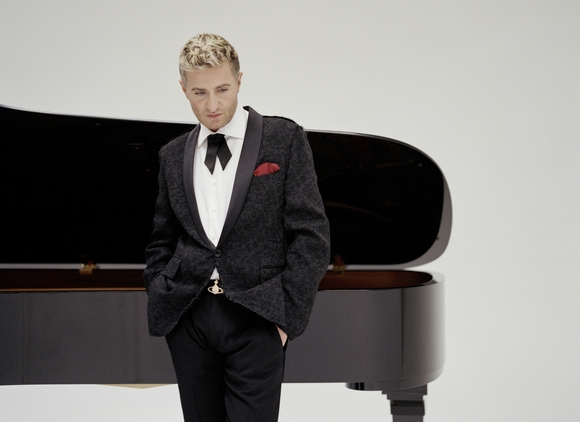
French Pianist Thibaudet
San Diego and its symphony orchestra under the baton of maestro Jahja Ling, of Chinese descent, and with a long association with the illustrious Cleveland Orchestra, inaugurated its new musical season a few days ago by greeting Thibaudet like a Hollywood star, and Thibaudet reciprocated with noticeable generosity. He presented two captivating piano pieces by the French composer Maurice Ravel (known for his popular ‘Bolero’ based on an Arab - Spanish tune) where the piano competes with the orchestra. They were the Piano Concerto in G and the Piano Concerto for the Left Hand which Ravel wrote for his pianist friend who lost his right arm during the First World War. The program also included two pieces for the orchestra focusing on the festivities of Rome by the French composer Berlioz and the Italian composer Respighi depicting the celebrations of Romans in the Colisseum with fighting lions and the old witch’s (La Befana) festival. The concert took place in the San Diego Symphony Concert Hall built using Spanish – Mexican architectural style when Southern California was still under Mexican rule.
Thibaudet is well-known in the United States since he lives between Paris and Los Angeles and specializes in French music, especially Ravel, even though he is equally at home with German music, particularly Brahms. His popularity grew dramatically some 13 years ago when he recorded with Decca Records two American jazz albums. The first CD was called “Conversations with Bill Evans“, the well-known jazz musician based in New York during the sixties, and the second was entitled “Reflections on Duke Ellington“, one of the giants of American jazz in the forties and fifties. His famous songs were rewritten for the piano especially for Thibaudet to play.
We witnessed Thibaudet’s sparkling brilliance in his competition with the San Diego Symphony Orchestra and its conductor, Jahja Ling who, with splendid style, ensured an ideal standard of harmony between the two as foreseen in Ravel’s score. The enthusiastic public were thrilled when Thibaudet succeeded in expressing Ravel’s feelings in the jazz element of both concertos because his approach conveys love, intimacy and deep emotions. His bravura lies in applying strict classical music standards on improvised jazz melodies and rhythm. His style is unique among modern pianists who play 20th century music crossing the artificial lines between classical and jazz. He reflected sincerely and without exaggeration Ravel’s supreme technical mastery and his urge to incorporate jazz in these works composed in the 1930s since Ravel was an admirer of the American composer Gershwin known since then for his masterpiece “American in Paris”. In an interview in the thirties Ravel revealed that he wrote both concertos at the same time and that the Piano Concerto in G follows Mozart’s traditional form of 3 movements while using certain effects borrowed from jazz, but only in moderation. It is both jovial and brilliant without necessarily being profound or dramatic. The Concerto for the Left Hand is quite different, and has only one movement with many jazz effects creating vitality and exciting energy permitting melodic phrases to move from one to another smoothly. Thibaudet followed the composer’s wishes and gave a rest to his right hand while using the left hand to play his part in an exciting 20 minutes marked by great discipline while creating the necessary contrast between the soft and fast sections then concluding the piece and the improvised part abruptly. The admiring audience roared in applause enchanted by the beautiful competition between the piano and the orchestra that ended on an equal par.
The whole concert was quite international as evidenced in the last piece on Roman Festivals by the Italian composer Respighi, student of the great Russian composer Rimsky-Korsakov known for his “ Shehrezade”. Respighi’s piece demonstrated unequivocally the effect of the professor on his student in the excellent orchestration and use of musical colors through an intelligent choice of various instruments that conveys to the listener the feeling that he has moved from the concert hall to the witch’s festival (La Befana) in Piazza Navona in central Rome where children were celebrating the arrival on a broom of the legendary ugly old woman bringing them gifts while they were turning on the merry-go-round. Descriptive program music helped create an atmosphere of joy and delight more effectively than Hollywood movies.
San Diego, after its expansion in recent years and the arrival of many new inhabitants from various other states attracted by its natural beauty and mild weather, is becoming another cultural hub, even in a limited way compared to other US cities. In addition to music, painting and theatre are given a lot of prominence. At present an important and rare exhibition, “From El Greco to Dali”, is being held at The San Diego Museum of Art located in the beautiful Balboa Park. On view are some gems of Spanish art part of the private collection of a wealthy Mexican who collected some distinctive paintings by Picasso never shown anywhere else. After the concert was over, I asked one of the ushers in the concert hall, “ I wonder if Thibaudet knows about this exposition in Balboa Park and whether he will take advantage to see it and enjoy Picasso’s paintings? “ The reply came with some humor and some perplexity ,”I don’t believe so because he does not have sufficient time; he is obliged to fly back to Paris, but he may go tonight to the nearby Picasso restaurant and enjoy Spanish tapas - appetizers ! “
Thibaudet is well-known in the United States since he lives between Paris and Los Angeles and specializes in French music, especially Ravel, even though he is equally at home with German music, particularly Brahms. His popularity grew dramatically some 13 years ago when he recorded with Decca Records two American jazz albums. The first CD was called “Conversations with Bill Evans“, the well-known jazz musician based in New York during the sixties, and the second was entitled “Reflections on Duke Ellington“, one of the giants of American jazz in the forties and fifties. His famous songs were rewritten for the piano especially for Thibaudet to play.
We witnessed Thibaudet’s sparkling brilliance in his competition with the San Diego Symphony Orchestra and its conductor, Jahja Ling who, with splendid style, ensured an ideal standard of harmony between the two as foreseen in Ravel’s score. The enthusiastic public were thrilled when Thibaudet succeeded in expressing Ravel’s feelings in the jazz element of both concertos because his approach conveys love, intimacy and deep emotions. His bravura lies in applying strict classical music standards on improvised jazz melodies and rhythm. His style is unique among modern pianists who play 20th century music crossing the artificial lines between classical and jazz. He reflected sincerely and without exaggeration Ravel’s supreme technical mastery and his urge to incorporate jazz in these works composed in the 1930s since Ravel was an admirer of the American composer Gershwin known since then for his masterpiece “American in Paris”. In an interview in the thirties Ravel revealed that he wrote both concertos at the same time and that the Piano Concerto in G follows Mozart’s traditional form of 3 movements while using certain effects borrowed from jazz, but only in moderation. It is both jovial and brilliant without necessarily being profound or dramatic. The Concerto for the Left Hand is quite different, and has only one movement with many jazz effects creating vitality and exciting energy permitting melodic phrases to move from one to another smoothly. Thibaudet followed the composer’s wishes and gave a rest to his right hand while using the left hand to play his part in an exciting 20 minutes marked by great discipline while creating the necessary contrast between the soft and fast sections then concluding the piece and the improvised part abruptly. The admiring audience roared in applause enchanted by the beautiful competition between the piano and the orchestra that ended on an equal par.
The whole concert was quite international as evidenced in the last piece on Roman Festivals by the Italian composer Respighi, student of the great Russian composer Rimsky-Korsakov known for his “ Shehrezade”. Respighi’s piece demonstrated unequivocally the effect of the professor on his student in the excellent orchestration and use of musical colors through an intelligent choice of various instruments that conveys to the listener the feeling that he has moved from the concert hall to the witch’s festival (La Befana) in Piazza Navona in central Rome where children were celebrating the arrival on a broom of the legendary ugly old woman bringing them gifts while they were turning on the merry-go-round. Descriptive program music helped create an atmosphere of joy and delight more effectively than Hollywood movies.
San Diego, after its expansion in recent years and the arrival of many new inhabitants from various other states attracted by its natural beauty and mild weather, is becoming another cultural hub, even in a limited way compared to other US cities. In addition to music, painting and theatre are given a lot of prominence. At present an important and rare exhibition, “From El Greco to Dali”, is being held at The San Diego Museum of Art located in the beautiful Balboa Park. On view are some gems of Spanish art part of the private collection of a wealthy Mexican who collected some distinctive paintings by Picasso never shown anywhere else. After the concert was over, I asked one of the ushers in the concert hall, “ I wonder if Thibaudet knows about this exposition in Balboa Park and whether he will take advantage to see it and enjoy Picasso’s paintings? “ The reply came with some humor and some perplexity ,”I don’t believe so because he does not have sufficient time; he is obliged to fly back to Paris, but he may go tonight to the nearby Picasso restaurant and enjoy Spanish tapas - appetizers ! “









 Home
Home Politics
Politics









